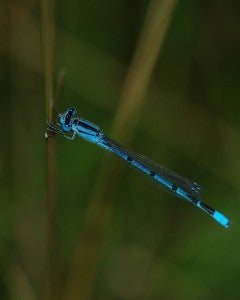Dragonflies and damselflies call OMSP home
Published 1:34 pm Tuesday, August 11, 2015
By EMILY D. COOK / Community Columnist
Anytime you have water nearby, you are almost ensured of seeing either dragonflies or damselflies.

Dragonflies and damselflies, such as the Familiar Bluet, can be spotted in Oak Mountain State Park. (Contributed)
We see them all the time at Oak Mountain State Park because of our lakes and streams.
Why do you find them near water? One because of the food they eat, and two because they lay their eggs in water.
Dragonflies and damselflies go through incomplete metamorphosis, only have three stages but during their larval stage they can molt six to 15 times.
Dragonflies and damselflies belong to the Order Odonata, which means toothed ones, which is interesting being that they are voracious predators, eating termites or flying ants, mayflies, caddisflies or gnats, occasionally even mosquitoes.
Not only do they help control insect populations, we can look at the number of their aquatic nymphs to determine a stream’s quality of health.
If there are large numbers of dragonfly or damselfly nymphs, it is a good possibility that the stream is unpolluted.
Dragonflies and damselflies look so similar to each other, but there are a few simple things to look for to distinguish between the two.
One of those is to look at the position of the wings when the insect has landed.
If it is open and out to the side it is a dragonfly; if it is closed and pointed to the back it is a damselfly.
Another way is to look at the eyes. If they touch or almost touch, then it is a dragonfly; if they are completely separate, then it is a damselfly.
Dragonflies and damselflies come in all colors and sizes.
Dragonflies and damselflies have iridescent and metallic colors on their bodies, but damselflies can be great camouflage users when landing out of direct sunlight.
A few dragonflies and damselflies to look for in Oak Mountain are the Green Darner, Blue Dasher, Familiar Bluet and the American Rubyspot. These are just a few, as there are more than 5,500 recognized species of dragonflies and damselflies in the world.
Come out to enjoy the park and take the time to look for the dragonflies and damselflies that call Oak Mountain State Park home.
Remember that you keep Alabama State Parks open by visiting them.









